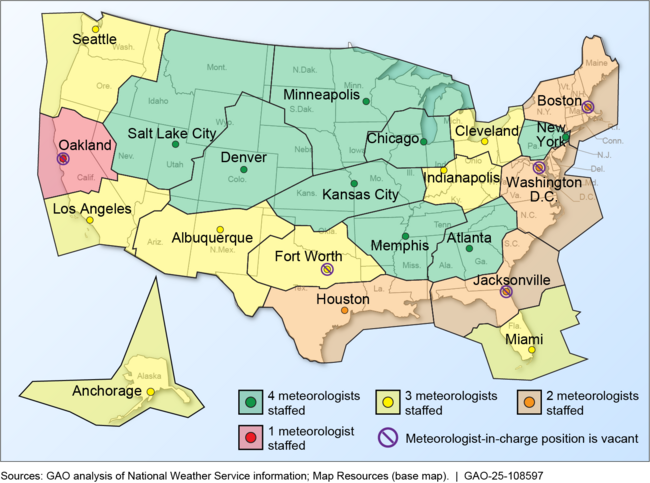Aviation Meteorologists: Urgent Actions Needed to Address Staffing Concerns
Fast Facts
Bad weather can snarl air travel. Air traffic controllers make weather-related decisions, like changing a plane's route, for safety and efficiency.
The National Weather Service puts aviation meteorologists on-site at the Federal Aviation Administration's air traffic control centers to help. They give regular briefings and can tailor a forecast for a specific route if needed.
However, the number of aviation meteorologists has fallen considerably, with remaining staff under strain to provide the needed services. We recommended that FAA consult with the National Weather Service to identify related risks and take urgent action to address them.

Highlights
What GAO Found
Adverse weather can impact aviation operations and affects Federal Aviation Administration (FAA) decisions in facilitating and ensuring the safe and efficient use of the National Airspace System. To help FAA make these decisions, meteorologists from the National Weather Service provide decision support services to FAA for any weather event that could have an impact on air traffic operations and flight safety. A group of these meteorologists—known as a center weather service unit—are on site at each of FAA’s 21 Air Route Traffic Control Centers. Meteorologists are also present at the FAA Air Traffic Control System Command Center.
Under a 2016 interagency agreement between FAA and the Weather Service—set to expire in September 2025—the Weather Service was required to staff 90 positions with full-time equivalent meteorologists for these centers, and FAA must reimburse the Weather Service for the associated personnel costs, subject to the availability of annual appropriations. In July 2024, FAA officials informed the Weather Service that they planned to reduce the number of meteorologists to 71 by the end of 2024, but the Weather Service urged FAA to reconsider, stating that this could lead to serious safety and economic consequences. Ultimately, FAA and the Weather Service agreed to cap staffing at 81 full-time equivalents for fiscal year 2025 through an amendment to the 2016 interagency agreement. FAA officials stated that natural attrition had kept staff at an average of 81 meteorologists from 2019-2024.
According to the Weather Service, as of June 2025, meteorologist staffing had fallen to 69 active meteorologists as staffing levels have been affected by the federal hiring freeze and deferred resignation program. According to the Weather Service and an association representing meteorologists, having fewer meteorologists has strained the remaining staff. Across 21 central weather service units, five are staffed with one or two meteorologists, while 8 are fully staffed with four each (see figure).
National Weather Service Meteorologists Staffed at the 21 Central Weather Service Units as of June 2025
Weather Service officials stated that they had several mitigation actions underway—such as providing remote services from other Weather Service offices and working to fill open positions. Airline representatives and associations representing meteorologists, air traffic controllers, and airlines expressed various concerns about the current meteorologist staffing levels, including safety concerns due to overworked meteorologists and the loss of expertise when services are conducted by a back-up meteorologist. FAA officials stated they are analyzing the current staffing model and identifying risk mitigations for current staffing challenges and future interagency negotiations.
However, FAA has not yet fully identified, and thus, has not developed specific actions it could take to address, the potential risks to the safety and efficiency of the National Airspace System posed by current meteorologist staffing levels. While FAA and the Weather Service are engaged in a number of activities—including hiring more meteorologists and negotiating a future staffing agreement—it is unclear that these activities will produce the desired results in the nearer term for addressing risks to the safety and efficiency of the National Airspace System when meteorologist staffing levels change. FAA officials said that Weather Service staffing is an internal workforce matter under the authority of Commerce. However, FAA is ultimately and statutorily responsible for the safety and efficiency of the National Airspace System. Identifying and taking urgent action to address risks related to staffing in the nearer term, in close consultation with the Weather Service, would help FAA ensure the safety and efficiency of an already-stressed system
Why GAO Did This Study
FAA is responsible for ensuring the safety and efficiency of more than 45,000 flights per day in the National Airspace System. The system is currently under tremendous strain as air traffic controller shortages and periodic equipment failures in aging air traffic control systems are leading to delayed and canceled flights. GAO is issuing this report to inform the Departments of Transportation and Commerce and Congress about another stressor on the National Airspace System. Severe weather can exacerbate strains on the system and can lead to compounded adverse conditions for passengers.
As part of GAO’s ongoing work on aviation operational preparedness, GAO reviewed FAA and Weather Service documents and relevant statutes. GAO interviewed FAA and Weather Service officials, nine passenger and cargo airlines, and four associations representing meteorologists, air traffic controllers, airlines, and pilots.
Recommendations
GAO is making one recommendation that FAA, in close consultation with the Weather Service, should fully identify potential risks to the safety and efficiency of the national airspace system caused by current meteorologist staffing levels and take urgent action to address them.
The Department of Transportation concurred with our recommendation and stated that it is collaborating with the Weather Service to develop a new service delivery model for the future
Recommendations for Executive Action
| Agency Affected | Recommendation | Status |
|---|---|---|
| Federal Aviation Administration | The Administrator of FAA, in close consultation with NWS, should fully identify potential risks to the safety and efficiency of the NAS caused by current meteorologist staffing levels and take urgent action to address them. (Recommendation 1) |
When we confirm what actions the agency has taken in response to this recommendation, we will provide updated information.
|

